We traveled to Phoenix via Interstate10, and I was skeptical when I saw this segment designated as a Scenic Highway. I mean, I like the desert, but I wasn’t expecting real scenicness. But it was, it was just beautiful, right from the hills of Banning Canyon on the north that looked like the green rug my brother Steve used to heap up to make hills for train layouts 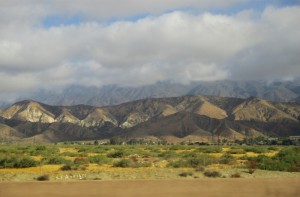
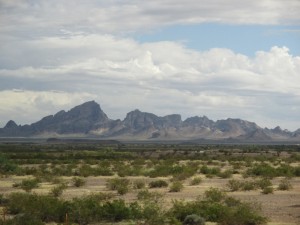
In fact, we arrived in Phoenix in the last moments of a huge rainstorm that brought down trees, caused widespread power outages, and dumped record rainfall on Sky Harbor Airport. (Note: best airport name anywhere!) 
So why did I not have an Arizona map? It’s not like me to be unprepared in that way. It’s because we hadn’t planned to be in Arizona. The next chapter of this trip takes place in southern Utah, visiting the national parks there, and we had thought we’d be driving there through Nevada (which I do have a map for). But recently I got to thinking about the fact that it’s going to be hard for me to visit the Arizona Diamondbacks stadium during baseball season because I don’t want to GO to Arizona during baseball season – too hot! Then it’s also a fact that it’s possible to get to Utah by way of Phoenix rather than Las Vegas, that the last day of the regular baseball season is two days after the end of the muster, and that Phoenix is only 167 miles east of Hemet, so – here we are!
Chase Field, in downtown Phoenix, is about the same age as the Mariners’ Safeco Field, but the two are so different. For starters, Chase has a roof that is closed almost all the time due to the heat, so it has the feel of an indoor stadium, although there is glass that lets in sunlight high up, and natural grass. (Safeco doesn’t actually have a roof – it has a sort of umbrella, so it’s never completely closed, and when the roof is extended you can see the rain falling.) I know a lot of people like Chase, but for me an indoor baseball stadium immediately loses its raison d’être, and I just can’t like it very much.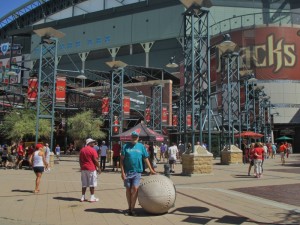
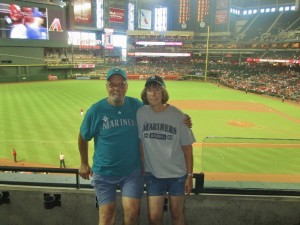
However, for some reason we could never tell what the actual score in the game was. It was probably up there somewhere, but there was no plain hand-operated score board that would tell you what inning it was, and who was winning. It was all too busy and confusing. I compare it to the scoreboard at Fenway Park, which was also electronic, expensive, and sophisticated, but which somehow retained the simplicity and directness of an old-fashioned scoreboard.
We took our walkabout around the concourses and found much to like on the main concourse. The field is easily seen from everywhere, although places to relax and view the game from other than your paid seat were few. There are lots of suites. One unique feature of this stadium: a swimming pool and hot tub just beyond the right-centerfield fence. You have to reserve it ahead of time, just as you would a suite, for a mere $3500 per game. But you can invite up to 35 friends, and the pool opens two hours before first pitch and includes food and beverage – what a deal!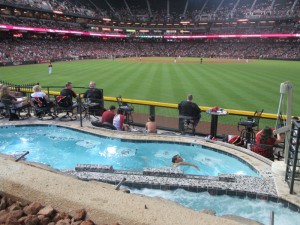
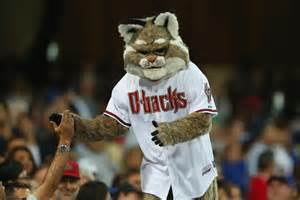
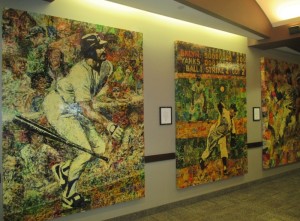
Now, I know you’re wondering about the food. Chase Field offers a huge variety of food throughout the ballpark and the concourse is lined with concession stands, permanent ones along the outside wall and various carts that are right above the seating areas, where they don’t block your view of the game. Many carts offer the D-Backs signature $4 beer, billed as the cheapest beer in Major League Baseball. There are chain outlets such as Fatburgers, Panda Express, Subway, and Cold Stone Creamery, which I don’t like to see at ballparks (although that didn’t stop us from having some CSC ice cream, very yummy).
Deciding what to eat took some research and thought, but we finally settled on a $7 Sonoran-style hot dog from Red Hot Grill. The thick, juicy dog comes wrapped in mesquite-smoked bacon, covered in pico de gallo and ranch-style beans, with an artistic drizzle of some sort of white stuff over all (sour cream? mayo?). Messy, but very, very tasty.

I was quite distracted, though, throughout the game because simultaneously the Mariners were playing the Angels with a wild-card spot in the playoffs at stake. The Ms won, but we needed the As to lose to the Rangers at the same time, and unfortunately they didn’t. Sigh. So baseball is over for this season for the Mariners, but we’re amazed at and proud of what they accomplished this year. As far as who won the Diamondbacks-Cardinals game, I dunno. Never figured it out.
